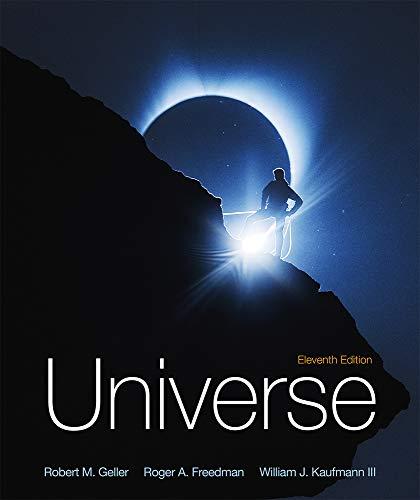
Concept explainers
The fraction of the total volume of the Earth occupied by the crust, the mantle, and the core respectively.
Answer to Problem 16Q
Solution:
Explanation of Solution
Introduction:
The Earth is made up of three portions that are named as following:
1. The crust which is the outermost portion of the Earth having depth of about
2. The core which is the innermost portion of the Earth.
3. The mantle which is in between the crust and the core and constitutes maximum volume of the Earth.
The volume of the Earth is proportional to the cube of its radius. This can be expressed as:
Here
Explanation:
The Earth consists of three layers beneath its upper surface. These are the core (innermost), the mantle (middle) and the crust (outermost).
The crust does not go beyond
The volume of the Earth
Substitute
The volume of the mantle
Substitute
And, the average volume of the crust
Substitute
Conclusion:
Hence, the fraction of the crust to the total volume is
Want to see more full solutions like this?
Chapter 9 Solutions
Universe
- Gold has a density of 19.3 gm/cm3. If a gold coin has a mass of 60 grams and a thickness of 0.3 cm, what would you estimate its diameter to be?arrow_forwardIf 200 oak trees are counted on a 2 km x 2 km patch of land, what is the density of maple trees per square kilometer? What is the density of the oak trees per km2?arrow_forwardA particular mountain is 7,550 meters above sea level. How far above sea level is this mountain in feet?arrow_forward
- The Grinnell Glacier in Glacier National Park had a surface area of 1,020,009 square meters in 1966. Its area was 615,454 square meters in 2005. The 2005 surface area is what percentage of the 1966 surface area?arrow_forwardDensity is always expressed as mass per unit volume. If an organic liquid has a density of 0.9 grams per cubic centimeter and if 1 cubic feet is 7.481 gallons, How many cubic feet are needed to hold 1000 pounds of the liquid? how many gallons?arrow_forwardAntarctica is roughly semicircular in shape, with a radius of 2000 km. The average thickness of the ice cover is 3000 m. How many metric tons (1metric ton = 1000 kg) of ice cover Antarctica? (Consider: density of ice = 0.919 gram per cubic centimeter)arrow_forward
- Antarctica is roughly semicircular, with a radius of 2000 km . The average thickness of its ice cover is 3000 m. How many cubic centimeters of ice does Antarctica contain? (Ignore the curvature of Earth.)arrow_forwardThe Richter Soale is a simple equation for measuring intensity of an earthquake, according to the formula R=log(I), where I is Intensity of an earthquake and Ris the Richter scale rating. The largest earthquake in the year 2006 was in the ocean that was recorded as an 8.3 on the Richter Scale. The most devastating earthquake was in a major city that registered 6.6 on the Richter Scale. How many times more intense was the quake in the ocean? a) The intensity of the 8.3 earthquake was: You can write it as a power of 10 b) The intensity of the 6.6 earthquake was: FYou can write it as a power of 10} c) The quake in the ocean was times more intense than the one in the city. (Round to 3 decimal places.)arrow_forwardThe volume of Earth is on the order of 1021m3. (a) What is this in cubic kilometers (km3)? (b) What is it in cubic miles (mi3)? (c) What is it in cubic centimeters (cm3)?arrow_forward
- The volume of all the people on earth in cubic kilometers. If a large mine is about 3 km across and 1 km deep, would they all fit?arrow_forwardThe density of atmospheric air varies with elevation (2), decreasing with increasing altitude. a) Using the date given in Table 2, obtain a relation for the variation of density (p) with elevation (2). Assume the earth to be a perfect sphere with a radius (r) of 6377 km and the thickness of the atmosphere is 25 km as illustrated in Figure 1. b) Calculate the density of atmosphere air at an elevation of 7000 m. Atmosphere thickness = 25 km Earth radius, r= 6377 km www 6381 were 6382 Table 2: Density of atmosphere related to earth radius. Radius r, km 6377 6378 6379 6380 6383 6385 6387 6392 6397 6402 *r=z+6377 km Find density of air a Earth surface Density p. kg/m³ 1.225 1.112 7 km 1.007 0.9093 0.8194 0.7364 0.6601 0.5258 0.4135 0.1948 0.08891 0.04008arrow_forwardThe average density of the earth is 5.52 g/cm3. What is its density in ug/mm3arrow_forward
 An Introduction to Physical SciencePhysicsISBN:9781305079137Author:James Shipman, Jerry D. Wilson, Charles A. Higgins, Omar TorresPublisher:Cengage Learning
An Introduction to Physical SciencePhysicsISBN:9781305079137Author:James Shipman, Jerry D. Wilson, Charles A. Higgins, Omar TorresPublisher:Cengage Learning
 AstronomyPhysicsISBN:9781938168284Author:Andrew Fraknoi; David Morrison; Sidney C. WolffPublisher:OpenStax
AstronomyPhysicsISBN:9781938168284Author:Andrew Fraknoi; David Morrison; Sidney C. WolffPublisher:OpenStax


